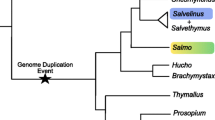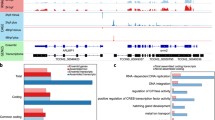Abstract
Alternative splicing (AS) is a mechanism by which the coding diversity of the genome can be greatly increased. Rates of AS are known to vary according to the complexity of eukaryotic species potentially explaining the tremendous phenotypic diversity among species with similar numbers of coding genes. Little is known, however, about the nature or rate of AS in teleost fish. Here, we report the characteristics of AS in teleost fish and classification and frequency of five canonical AS types. We conducted both same-species and cross-species analysis utilizing the Genome Mapping and Alignment Program (GMAP) and an AS pipeline (ASpipe) to study AS in four genome-enabled species (Danio rerio, Oryzias latipes, Gasterosteus aculeatus, and Takifugu rubripes) and one species lacking a complete genome sequence, Ictalurus punctatus. AS frequency was lowest in the highly duplicated genome of zebrafish (17% of mapped genes). The compact genome of the pufferfish showed the highest occurrence of AS (~43% of mapped genes). An inverse correlation between AS frequency and genome size was consistent across all analyzed species. Cross-species comparisons utilizing zebrafish as the reference genome allowed the identification of additional putative AS genes not revealed by zebrafish transcripts. Approximately, 50% of AS genes identified by same-species comparisons were shared among two or more species. A searchable website, the Teleost Alternative Splicing Database, was created to allow easy identification and visualization of AS transcripts in the studied teleost genomes. Our results and associated database should further our understanding of alternative splicing as an important functional and evolutionary mechanism in the genomes of teleost fish.





Similar content being viewed by others
References
Aparicio S, Chapman J, Stupka E, Putnam N, Chia J, Dehal P, Christoffels A, Rash S, Hoon S, Smit A et al (2002) Whole-genome shotgun assembly and analysis of the genome of Fugu rubripes. Science 297:1301–1310
Black DL (2003) Mechanisms of alternative pre-messenger RNA splicing. Ann Rev Biochem 72:291–336
Boue S, Letunic I, Bork P (2003) Alternative splicing and evolution. BioEssays 25:1031–1034
Brett D, Hanke J, Lehmann G, Haase S, Delbruck S, Krueger S, Reich J, Bork P (2000) EST comparison indicates 38% of human mRNAs contain possible alternative splice forms. FEBS Lett 474:83–86
Brett D, Pospisil H, Valcarcel J, Reich J, Bork P (2002) Alternative splicing and genome complexity. Nature Genet 30:29–30
Chen FC, Chen CJ, Ho JY, Chuang TJ (2006) Identification and evolutionary analysis of novel exons and alternative splicing events using cross-species EST-to-genome comparisons in human, mouse and rat. BMC Bioinform 7:136
Graveley BR (2001) Alternative splicing: increasing diversity in the proteomic world. Trends Genet 17:100–107
Hiller M, Huse K, Platzer M, Backofen R (2005) Creation and disruption of protein features by alternative splicing a novel mechanism to modulate function. Genome Biol 6:R58
Hofstetter G, Berger A et al (2010) Alternative splicing of p53 and p73: the novel p53 splice variant p53delta is an independent prognostic marker in ovarian cancer. Oncogene 29:1997–2004
Hukriede NA, Joly L, Tsang M, Miles J, Tellis P, Epstein JA, Barbazuk WB, Li FN, Paw B, Postlethwait JH et al (1999) Radiation hybrid mapping of the zebrafish genome. Proc Natl Acad Sci USA 96:9745–9750
Kasahara M, Naruse K, Sasaki S, Nakatani Y, Qu W, Ahsan B, Yamada T, Nagayasu Y, Doi K, Kasai Y et al (2007) The medaka draft genome and insights into vertebrate genome evolution. Nature 447:714–719
Kim N, Alekseyenko AV, Roy M, Lee C (2007) The ASAP II database: analysis and comparative genomics of alternative splicing in 15 animal species. Nucleic Acids Res 35:D93–D98
Maniatis T, Tasic B (2002) Alternative pre-mRNA splicing and proteome expansion in metazoans. Nature 418:236–243
Mironov AA, Fickett JW, Gelfand MS (1999) Frequent alternative splicing of human genes. Genome Res 9:1288–1293
Modrek B, Resch A, Grasso C, Lee C (2001) Genome-wide detection of alternative splicing in expressed sequences of human genes. Nucleic Acids Res 29:2850–2859
Navratilova P, Fredman D, Lenhard B, Becker TS (2010) Regulatory divergence of the duplicated chromosomal loci sox11a/b by subpartitioning and sequence evolution of enhancers in zebrafish. Mol Genet Genomics 283:171–184
Nigumann P, Redik K, Matlik K, Speek M (2002) Many human genes are transcribed from the antisense promoter of L1 retrotransposon. Genomics 79:628–634
Peatman E, Liu ZJ (2006) CC chemokines in zebrafish: Evidence for extensive intrachromosomal gene duplications. Genomics 88:381–385
Robinson-Rechavi M, Marchand O, Escriva H, Laudet V (2001) An ancestral whole-genome duplication may not have been responsible for the abundance of duplicated fish genes. Curr Biol 11:R458–R459
Sahoo A, Im SH (2010) Interleukin and interleukin receptor diversity: role of alternative splicing. Int Rev Immunol 29:77–109
Sammeth M, Foissac S, Guigo R (2008) A general definition and nomenclature for alternative splicing events. PLOS Comp Biol 4(8):e1000147
Santini F, Harmon LJ, Carnevale G, Alfaro ME (2009) Did genome duplication drive the origin of teleosts? A comparative study of diversification in ray-finned fishes. BMC Evol Biol 9:194
van der Aa LM, Levraud JP, Yahmi M, Lauret E, Briolat V, Herbomel P, Benmansour A, Boudinot P (2009) A large new subset of TRIM genes highly diversified by duplication and positive selection in teleost fish. BMC Biol 7:7
Vinogradov AE (1998) Genome size and GC-percent in vertebrates as determined by flow cytometry: The triangular relationship. Cytometry 31:100–109
Wang BB, O’Toole M, Brendel V, Young ND (2008) Cross-species EST alignments reveal novel and conserved alternative splicing events in legumes. BMC Plant Biol 8:17
Wang S, Peatman E, Abernathy J et al (2010) Assembly of 500,000 inter-specific catfish expressed sequence tags and large scale gene-associated marker development for whole genome association studies. Genome Biol 11:R8
Wu TD, Watanabe CK (2005) GMAP: a genomic mapping and alignment program for mRNA and EST sequences. Bioinformatics 21:1859–1875
Xing Y, Lee C (2006) Alternative splicing and RNA selection pressure - evolutionary consequences for eukaryotic genomes. Nature Rev Genet 7:499–509
Yuan YA, Chung JD, Fu XY, Johnson VE, Ranjan P, Booth SL, Harding SA, Tsai CJ (2009) Alternative splicing and gene duplication differentially shaped the regulation of isochorismate synthase in Populus and Arabidopsis. Proc Natl Acad Sci USA 106:22020–22025
Acknowledgments
We would like to thank Dr. Bing-bing Wang for sharing the ASviewer software with us. This research was supported in part by funding from the USDA’s National Institute of Food and Agriculture.
Author information
Authors and Affiliations
Corresponding author
Additional information
Communicated by S. Hohmann.
J. Lu and E. Peatman contributed equally to this work.
Electronic supplementary material
Below is the link to the electronic supplementary material.
Rights and permissions
About this article
Cite this article
Lu, J., Peatman, E., Wang, W. et al. Alternative splicing in teleost fish genomes: same-species and cross-species analysis and comparisons. Mol Genet Genomics 283, 531–539 (2010). https://doi.org/10.1007/s00438-010-0538-3
Received:
Accepted:
Published:
Issue Date:
DOI: https://doi.org/10.1007/s00438-010-0538-3




